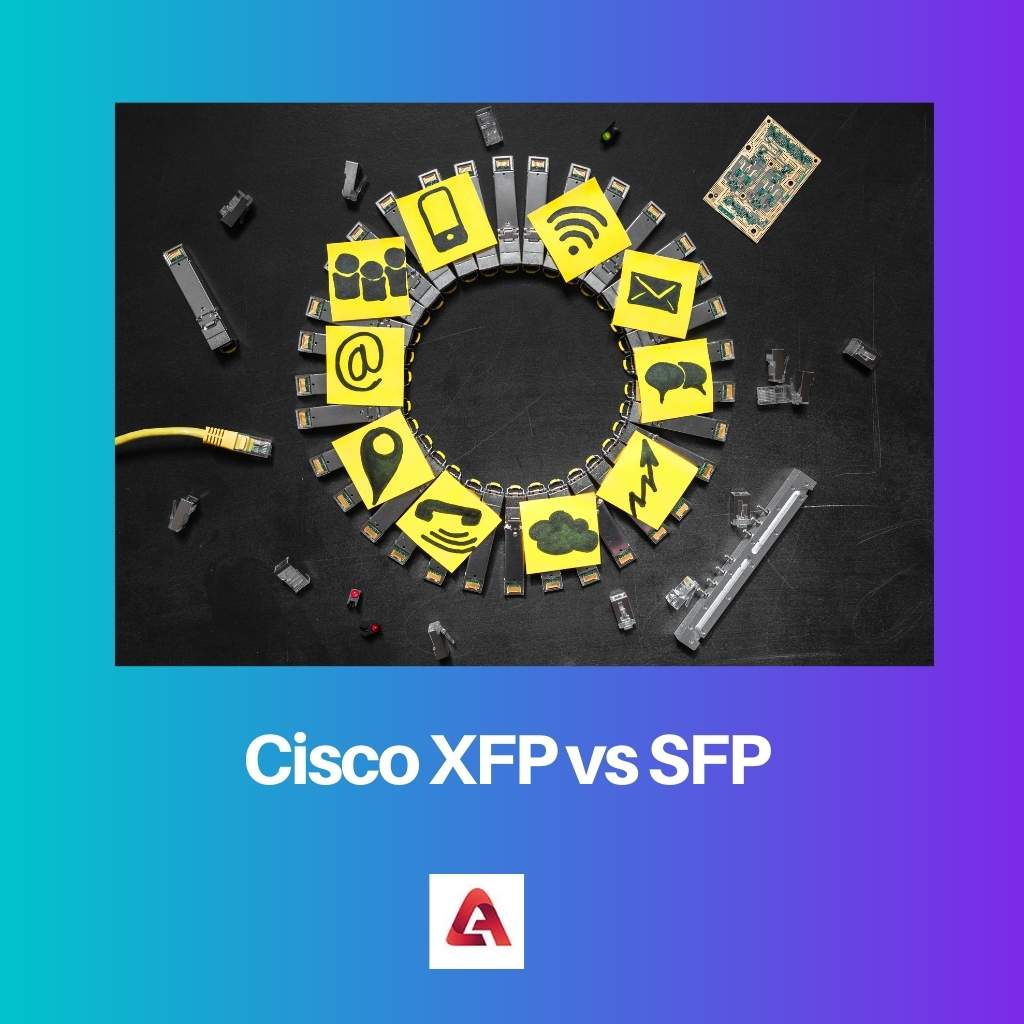Transceivers are the modern-day equipment for data transmission. Wireless communication has become an important part of our daily lives.
Cisco XFP and SFP are two of the best modules of data transmission today. Apart from being cost-effective, these systems have great signal quality.
Although the two are confused as meaning the same, they have considerable differences.
Key Takeaways
- XFP and SFP are small form-factor pluggable transceivers used in computer networking.
- XFP is larger than SFP and supports higher data rates.
- SFP is more commonly used than XFP.
Cisco XFP vs SFP
Cisco XFP is a modern-day transceiver and a module made by Cisco Systems that is used for data transmission. It is a hot-swappable input and output device. Cisco SFP is a module that works as a data transmitter to support speeds up to 4.25gb/s and is fitted with advanced transmission facilities.

Cisco XFP is a modern-day transceiver used for data transmission. With a data rate of 10Gbps, the XFP module is a hot-swappable input-output device.
It links the system module port with a fibre optic nerve. XFP can operate with only a single wavelength or dense wavelength division multiplexing techniques.
The SFP module operates as a data transmitter with better and faster transmission facilities. The SFP module can support speeds up to 4.25gbps.
The module follows the SFP transceiver multi-source agreement. SFP supports MM fibre, SM fibre, and UTP copper Media Type.
Some communication equipment supported by SFP are SONET, SFP Plus, 10 Gbps data rates, Gigabit Ethernet and Fibre Channel.
Comparison Table
| Parameters of Comparison | Cisco XFP | SFP |
|---|---|---|
| Full Form | Cisco XFP stands for 10 Gigabit Small Form Factor Pluggable. | SFP stands for Small Form-Factor Pluggable. |
| Transmission Distance | The transmission distance is 220m/300m/2km/10km/20km/40km/60km/80km/120km. | The SFP module supports a distance of 300m/2km/10km/15km/20km/40km/60km/80km/100km/120km/150km. |
| Size | The size of an XFP module is larger than that of an SFP module. | The size of an SFP module is smaller than that of an XFP module. |
| Price | The XFP module is more expensive than the SFP module. | The SFP module is cheaper than that of the XFP module. |
| Data Rate | The data rate of the XFP module is 10Gbps. | The data rate of the SFP module is 155M/622M/1.25G/2.5G/3G/4.25G. |
What is Cisco XFP?
Cisco XFP is one of the best modules to transmit data. Its full form is 10 Gigabit Small Form Factor Pluggable. XFP allows for fast data transmission on a computer system.
It came into existence in 2002 along with one of its electrical components – XFI. XFP Multi-Source Agreement Group is the inventor of the XFP module.
The XFP module is independent of the protocol. It functions at wavelengths that correspond to 850nm, 1310nm, or 1550nm.
The XFP modules are hot-swappable, i.e. the task of computer system components can take place without switching off the computer. In addition, the module follows the XFP MSA agreement.
To install the XFP module on your computer network, you must have either of the following: 10 Gbit/s Fibre Channel, Synchronous Optical Networking at OC-192 rates, 10 Gigabit Ethernet, Synchronous Optical Networking at STM-64, and Parallel Optics links. XFP can operate with only a single wavelength or dense wavelength division multiplexing techniques.
The data rate of the XFP module is 10Gbps. The XFP module uses an LC Duplex connector.
The transmission distance is 220m/300m/2km/10km/20km/40km/60km/80km/120km. The XFP module is significantly more expensive than the SFP module.
Conclusively, Cisco XFP is a large-sized, expensive module of fast data transmission on a computer network.
What is Cisco SFP?
Cisco SFP is a type of transceiver that facilitates significantly better telecommunications and signals than others. The full form of SFP is a Small Form-Factor Pluggable.
Another name of the SFP module is Mini GBIC. In addition, the function of the SFP module is similar to that of GBIC. However, it is smaller in form than the latter.
The protocol specifications of the SFP module are based on IEE802.3ae; XFP MSA. It has a practical application for Fast Ethernet Gigabit Ethernet Applications.
In addition, the SFP module can support speeds up to 4.25gbps. The module follows the SFP transceiver multi-source agreement.
The SFP module can link devices like switches and routers. Some communication equipment supported by SFP are SONET, SFP Plus, 10 Gbps data rates, Gigabit Ethernet and Fibre Channel.
The module works with wavelengths of varying dimensions. Moreover, it helps the users to locate the working status of SFP in real time.
Copper SFP uses an RJ45 interface. It is smaller in size than the XFP module. SFP supports MM fibre, SM fibre, and UTP copper Media Type. It supports a distance of 300m/2km/10km/15km/20km/40km/60km/80km/100km/120km/150km. The SFP module’s DOM function is discretionary.
Main Differences Between CISCO XFP and SFP
- Cisco XFP stands for 10 Gigabit Small Form Factor Pluggable. In contrast, SFP stands for Small Form-Factor Pluggable.
- The size of an XFP module is larger than that of an SFP module.
- The data rate of the XFP module is 10Gbps. On the other hand, the data rate of the SFP module is 155M/622M/1.25G/2.5G/3G/4.25G.
- The XFP module is more expensive than the SFP module.
- The transmission distance is 220m/300m/2km/10km/20km/40km/60km/80km/120km. On the other hand, the SFP module supports a distance of 300m/2km/10km/15km/20km/40km/60km/80km/100km/120km/150km.




